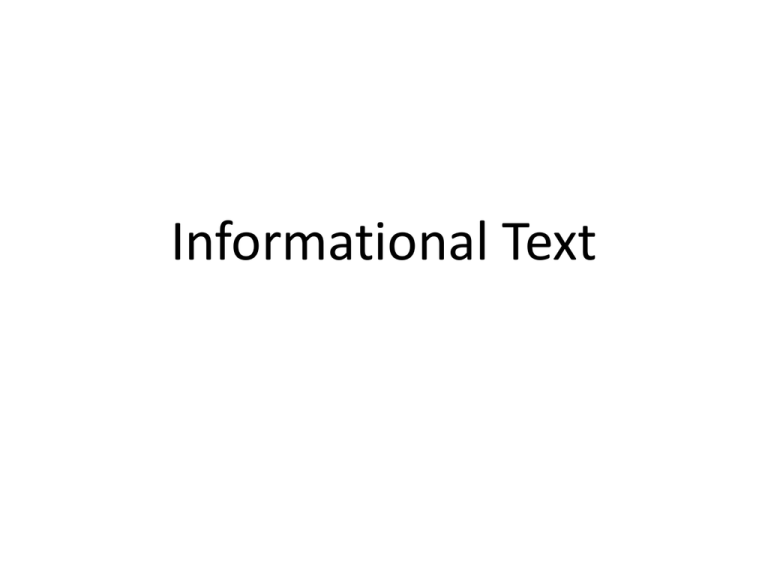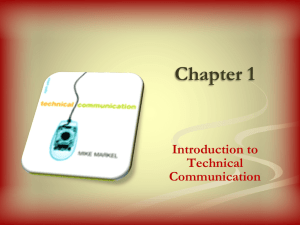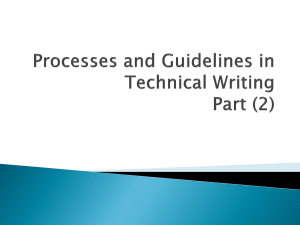Informational Text
advertisement

Informational Text VOCABULARY: • anecdote - short, entertaining account of something happening • vignette - a short, delicate literary sketch • quote - exact words spoken by someone and set off by quotation marks • flashback - recalling something that has happened in the past • tables - an arrangement of related facts, figures, values, etc. usually in rows and columns • charts - a group of facts about something set up in the form of a diagram • graph - a diagram (curve - broken line - series of bars) • snapshots - written description of how something looks • sketches - drawings • foreshadowing - hints of what is to happen in the future Feature Article • A feature article is a creative article that deals with real events, issues, and trends. • However, unlike straight news articles, it places emphasis on the people involved rather than on the facts of the news. There are seven types of feature articles described on these pages. • • • • • • • THE HUMAN-INTEREST FEATURE THE PERSONALITY FEATURE “THE BEST” ARTICLES THE NEWS FEATURE THE HOW-TO FEATURE THE PAST EVENTS FEATURE THE INFORMATIONAL FEATURE THE HUMAN-INTEREST FEATURE • This is the most common type of feature article. • This type typically reports on someone’s success in spite of great odds. • It may recall a tragic predicament. • It may share a continuing struggle supported only by hope and faith. THE PERSONALITY FEATURE • The subject of the article may be famous or not so famous but has done something of interest to others. • This type usually shows how a person gained recognition. • The personality feature is very much like a character sketch. “THE BEST” ARTICLES • The Courier-Journal has a column that publishes reviews of the “best” products of all kinds. • This type of article usually includes the writer’s personal experiences with the product. • It includes proof and examples that the product is the best of its kind. • The article includes information about where to get the product and how much it costs. • The article usually has a catchy title. THE NEWS FEATURE • This type of article brings a human-interest focus to breaking news. • It adds personal involvement to what may otherwise be a distant, seemingly unimportant event. THE HOW-TO FEATURE • This article explains how to do something – usually a complex process that most people would not know how to do. • The best how-to articles begin by telling the reader why it is important or beneficial for him or her to know how to do this. • The article explains the steps of the process in enough detail so that another person can do this process. • This article also includes a list of all of the materials needed to do this process. THE PAST EVENTS FEATURE • This article focuses on an historical event or historical celebration. • The article typically includes research but is not like an encyclopedia report. The article serves as a human interest history lesson. • This type of writing is usually puts a “human face” on history. In other words, it lets the reader know something about the people who were part of history. THE INFORMATIONAL FEATURE • This type of article shows insightful coverage of a topic. • It gives detailed information focused on one aspect of a given topic. • The article often refers to sources of research but is not like an encyclopedia report. Instead, the writer makes a personal connection to the subject and includes his/her voice. Various Ways to Include Details in an Article: Anecdotes Examples/Non-examples Vignettes Tables/Graphs/Charts Descriptions Facts Comparison Contrast Snapshots Pictures/Drawings Reasons Quotations Flashback Foreshadowing Types of Text Features: Headings Fonts Subheadings Bullets Offsets Text Boxes Color Ink Italics Bold Font Underlining All Capital Letters STRATEGIES FOR READING • • • • • • • • • • • • • • • • • • • • PREDICT Active readers attempt to figure out what will happen next and how the text will end. VISUALIZE Active readers try to visualize the setting, characters, and events to help them to understand what's happening. CONNECT Active readers try to connect personally with what they're reading. Active readers look for similarities between the descriptions in the text and what they've experienced personally, heard about in the world, or read in another text. QUESTION Active readers ask questions about the text while they're reading. CLARIFY Active readers try to answer any questions they might have while reading by using context clues prior knowledge, rereading, or using other resources. EVALUATE Active readers develop opinions about what they're reading both during reading and after they've finished reading





